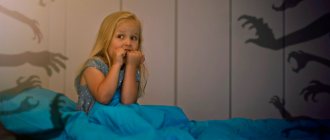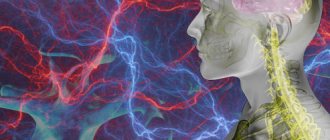Article:
Such a phenomenon as sleepwalking is not so rare in children. Sleep disturbance leads to the child getting out of bed, walking, and performing some actions. He does this unconsciously, and the next morning he doesn’t remember anything. Parents do not always understand the reason for this behavior, sometimes even consider it a mystical phenomenon. But there are very real reasons why it manifests itself in children. First of all, sleepwalking is explained by the peculiarities of the development of the children's nervous system. Most often, in adulthood, sleep improves. But sometimes we are talking about neurological pathology.
What is sleepwalking
Sleepwalking is also called somnambulism (or “sleepwalking”). Most often, this sleep disorder is observed in children over 4 years of age. Some of them experience periodic episodes of sleepwalking even in adolescence. This deviation can be combined with other types of parasomnia (sleep disorder). For example, a sleeping person talks and laughs under the impression of previously experienced emotions. Somnambulism has a similar nature to such manifestations as involuntary urination at night (enuresis) or nightmares.
Sleep disorder is due to the fact that the child’s brain cannot always adequately perceive the variety of information that enters it. His work continues even at night, when he is supposed to rest. The immature nervous system reacts violently to events that occur during the day, which continue to excite the brain during sleep. Impressed by a scary cartoon or movie, playing on the computer, an unpleasant or joyful meeting, or a quarrel with relatives, the child cannot fall asleep for a long time, and continues to worry in his sleep.
During normal sleep, the work of all parts of the brain, including those responsible for movement, is inhibited. Therefore, muscles relax, energy consumption decreases, and the body rests.
During episodes of sleepwalking in a child, part of the brain centers responsible for perception and awareness of reality is switched off, but the part that regulates physical activity continues to work. The brain sends false signals, and the body reacts to arousal caused by imaginary events.
How to treat sleepwalking in Saratov?
The Sarclinic doctor knows how to treat sleepwalking in Saratov . If the patient says: “I suffer from sleepwalking, what should I do?” We answer: “Go to a specialist for treatment!” At the first consultation, the doctor will tell you what childhood sleepwalking and adult sleepwalking , what teenage sleepwalking is (in teenagers), how to treat the disease sleepwalking, why conspiracies for sleepwalking do not help, whether the army and sleepwalking are combined, why sleepwalking is dangerous. You can ask the doctor a question for free online. Can sleepwalking acquired in adulthood be cured ? Yes, with complex treatment at Sarklinik.
Sign up for a consultation. There are contraindications. Specialist consultation is required.
Photo 1: Gnanamdesigns | Dreamstime.com\Dreamstock.ru. The people depicted in the photo are models, do not suffer from the diseases described and/or all similarities are excluded. Photo 2, 3: (©) Pechennikova VV | Sarclinic.com \ Sarclinic.ru
Related posts:
Very active child? Syndrome of movement disorders, disorders, motor disinhibition
Speech development disorders, speech development delay, treatment of mental retardation
Encopresis in children, neurotic encopresis, treatment of encopresis
Neuroses in children, childhood neurosis, treatment of neuroses
Vegetative vascular dystonia in children, treatment of VSD in Saratov
Comments ()
Causes of sleepwalking
As you know, people have 2 phases of sleep: slow and fast. During the night they alternate with each other, and this happens 4-5 times.
REM sleep can be superficial. When a person wakes up, he does not remember his dreams. If this phase prevails in duration, then he feels poorly rested and sleep-deprived.
NREM sleep normally lasts longer and occurs in 4 stages, each of which has its own characteristics (drowsiness, gradual shutdown of the brain, transition period and deep sleep). The last stage is the most difficult to awaken a person.
It is at the fourth stage of slow-wave sleep that children may experience manifestations of sleepwalking. Factors that provoke sleepwalking may include:
- strong feelings (both negative and positive);
- fear, fear of the dark, making sleep restless;
- mental stress due to workload at school, additional classes with tutors;
- lack of entertainment and active recreation, which children especially need.
The causes of somnambulism may be more serious. Sleepwalking manifests itself against the background of epilepsy, neuroses, mental illness, and brain damage. Brain function can be impaired as a result of head injury, tumor formation, as a consequence of meningitis, encephalitis and some other diseases. The cause of impaired brain activity in a baby is also infection with worms (they deprive the body of nutrients and, in addition, can penetrate directly into the brain).
Somnambulism is often a phenomenon that is inherited. The performance of involuntary actions during sleep is facilitated by a noisy environment surrounding a sleeping baby, sudden switching on of lights, or sleeping in a lit room.
The phenomenon was called “sleepwalking”, as it was noticed that the light of the moon can affect the sleeping person. Sleepwalking is more common during the full moon.
A similar phenomenon occurs more often in boys. In girls, episodes of sleepwalking are sometimes observed in connection with the appearance of menstruation and the corresponding hormonal changes in the body. The occurrence of sleep disturbances is facilitated by the presence of certain pathologies in the child, such as cardiac arrhythmia, asthma, night cramps, apnea (periodic stops of breathing).
Why is this happening?
Most often, children begin to sleepwalk at 4-5 years of age. This is exactly the age when a child is especially susceptible to everything. Brain structures are just being formed, there is no well-functioning functioning of mental functions yet, and the nervous system is under such a load that “failures” begin to occur in it. As a result, the brain does not stop working even at night. “Sleep paralysis” as such is not observed, only motor activity: sleepwalkers walk, sit down, stand up and even move objects. A very unusual case was also observed: a whole family drank tea in a dream. But no matter what a sleepwalker does at night, he will not remember it in the morning.
Psychologists list the following reasons for sleepwalking:
- Heredity. If mom or dad walked or walks at night, then most likely this will be passed on to the child.
- External factors. Poor sleep, a stressful situation, and exposure to medications can also trigger nighttime “adventures.”
- Conflicts and all the resulting childhood experiences. Quarrel at home, in kindergarten or at school, fears, resentments and punishments can disturb children's peace at night.
- Neurasthenia. Sleepwalking can be caused by infection of the nervous system, traumatic brain injury, and congenital pathologies.
If in the middle of the night you notice that your child is too active, do not rush to wake him up, but rather take care of his safety.
What is the danger of somnambulism?
Involuntary and uncontrollable actions performed by a sleepwalker lead to dangerous situations. When getting out of bed, he may trip or hit himself, pick up dangerous objects (scissors, a knife), or touch an electrical wire.
Warning: It is dangerous to leave a window or balcony open (the sleeper may fall out). A sleepwalker is able to open the door and go outside, into an unfamiliar place. A teenager is able to get into a car and drive away mechanically. Accordingly, a danger is created not only for himself, but also for the people around him.
How should parents and nannies behave?
Sleepwalking is not as scary for its anomalousness and mysticism as for injuries caused by negligence. It is important to organize a space in the house where not a single object will harm physical health. Hide potentially dangerous piercing, cutting, switched-on electrical appliances and wires. Often, sleepwalkers are directed precisely towards doors and windows, so all “exits” must be firmly closed and protected from easy opening. It also happens that they start opening locks with keys and even go outside, so hide them away too.
The most important thing is not to wake up the sleepwalker abruptly, because this can lead to severe fear, disorientation and even uncontrollable aggression. Just carefully lead him to the bed, you can talk to him, but calmly. Do the same if he resists or tries to perform some dangerous actions. If guests, relatives, or a nanny stay overnight at your place for the weekend, warn them and give these instructions so as not to scare anyone.
Manifestations and symptoms of sleepwalking
Uncontrolled sleep behavior leads to movements of varying complexity. In the best case, the sleeper assumes a sitting position, but he can also get out of bed, sort through toys, change clothes on his own, and go to the kitchen.
The feature is as follows:
- The sleepwalker's consciousness is switched off. Despite this, he is able to move actively and confidently. He automatically answers simple questions, but does not adequately perceive speech addressed to him.
- There is no sense of danger.
- The sleeper moves with his eyes open, but is not aware of what he sees. The facial expression does not change, emotions are not reflected on it.
- Memories of what happened during this time completely disappear.
- The episodes end with the child going back to bed or falling asleep where he finds the end of the episode of somnambulism, and then plunging into normal sleep. An episode of uncontrolled activity can last from 10 minutes to 1 hour. Usually begins 2-3 hours after the child falls asleep.
It is very difficult to wake up a sleepwalker while performing such involuntary actions. In this case, waking up after a loud shout, strong shaking, splashing with cold water can lead to the fact that the awakened person is very frightened, not understanding what is happening, and reacts aggressively.
Diagnostics
The first symptoms of sleepwalking require immediate contact with a neurologist. Only he will be able to determine what caused the disease and prescribe appropriate therapy.
Mandatory procedures will include not only blood and feces tests (for helminthiasis), but also examination of the fundus, ultrasound of the blood vessels of the brain and cervical spine.
To find out the true cause of sleep disorders, it is necessary to conduct an electroencephalogram, which records changes in brain impulses.
All these examinations will allow us to accurately formulate the cause of the development of sleepwalking.
Additionally, an MRI or CT scan, Doppler sonography may be required, and the specialist must collect an anamnesis as completely as possible and interview the parents about the presence of any psychological problems in the child.
Only after identifying the specific disease that led to somnambulism, the doctor prescribes appropriate therapy. Treatment may include various medications, alternative medicine and traditional recipes.
What to do if your child experiences somnambulism
Pediatricians do not consider sleepwalking a serious illness. According to the authoritative opinion of the famous doctor, author of popular programs about children's health, E. Komarovsky, there is no need to worry if such behavior in a child occurs sporadically in a dream, while it is clearly preceded by some specific provoking events. You just need to think about safety measures for the children themselves and those around them.
However, in some cases it is necessary to consult a doctor, especially if the episodes occur frequently, the child looks tired after them, or there are signs of physical and nervous exhaustion.
You should contact a pediatric neurologist or psychiatrist.
Parents' actions
If you find similar symptoms in your child, first of all, don’t panic. In this case, your actions should be as follows:
- You can’t wake up a somnambulist;
- carefully bring him to his sleeping place and lay him down;
- in rare cases, it is allowed to interrupt sleep with a soft and quiet voice.
If this phenomenon is detected, parents will need to visit a doctor and undergo an examination in order to exclude the development of central nervous system diseases. In addition, consultation with a neurologist is indicated.
However, the most important thing is to keep teenagers safe during sleepwalking episodes. To do this, do the following:
- remove all items from the children's room that could cause injury or cause a fire;
- if you live in a private house with several floors, place the child’s bedroom on the lower floor;
- securely secure the front door with several locks at night;
- Close all windows tightly at night so that the young somnambulist cannot open them.
And lastly, it is strictly forbidden to laugh or reproach the child during nighttime adventures. Otherwise, you will cause deep mental trauma to the baby.
How are sleep disorders diagnosed?
In order to establish how dangerous the existing phenomenon is in this case, the doctor must know how long the episodes last, how often they are repeated, and what actions the patient performs. The presence of additional manifestations (fainting, headaches, dizziness, other sleep disorders), as well as diseases and provoking factors, is taken into account.
A brain examination using MRI or electroencephalography (a procedure during which electrical impulses emitted by various parts of the brain are recorded) may be prescribed.
An effective method for identifying the causes of sleepwalking is polysomnography. Using sensors installed on different parts of the body and computer data processing, the activity of a sleeping person’s body is studied and deviations from the norm are identified.
How to treat somnambulism, sleepwalking, sleepwalking? How to get rid of sleepwalking?
The Sarclinic doctor knows how to treat sleepwalking , how to get rid of
sleepwalking! Effective treatments have cured many patients. Treatment using hardware and non-hardware methods allows you to achieve high efficiency and gives excellent results. Sarklinik provides treatment for somnambulism in Saratov, treatment for sleepwalking in Saratov, treatment for sleepwalking in Saratov for children, adolescents, adults, men, women.
Treatment for somnambulism
It is carried out when obvious health problems or pathologies associated with the state of the brain and nervous system are detected.
In the absence of obvious diseases, only recommendations are given on creating conditions for healthy sleep and eliminating factors that provoke the occurrence of disorders. In difficult cases, it is suggested to use hypnosis.
Indications for mandatory drug treatment are:
- the young patient has epilepsy (antiepileptic drugs Felbatol, Depakote are prescribed);
- the appearance of neuroses and depression (sedatives valerian, Novo-Passit, psychotropic drugs are used);
- detection of worms (antiparasitic drugs Pirantel, Dekaris are used).
If it is discovered that sleepwalking in children is a consequence of a brain tumor or head injury, surgical treatment is performed.
Diagnosis of sleepwalking, sleep-speaking (parasomnias) in Samara
“Unusual” clinical manifestations of parasomnias are often hidden by patients and other members of their family. To avoid progression of symptoms and maladjustment in society, you need to consult a somnologist.
In Samara, consultations with a somnologist are carried out at the First Neurology Children's Center. If necessary, the patient is referred for examination to a psychotherapist, neurologist, or cardiologist.
For an accurate diagnosis of parasomnias it is important:
- Assess the patient's sleep behavior;
- Compare motor phenomena with sleep phases;
- Exclude the convulsive (epileptic) nature of night attacks.
At the Somnology Center at the First Neurology clinic, an overnight polysomnographic study with video monitoring is carried out, as well as night EEG video monitoring. These studies will allow you to reliably establish a diagnosis and choose the right treatment tactics.











